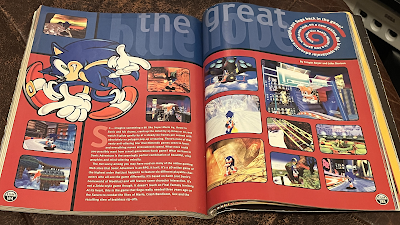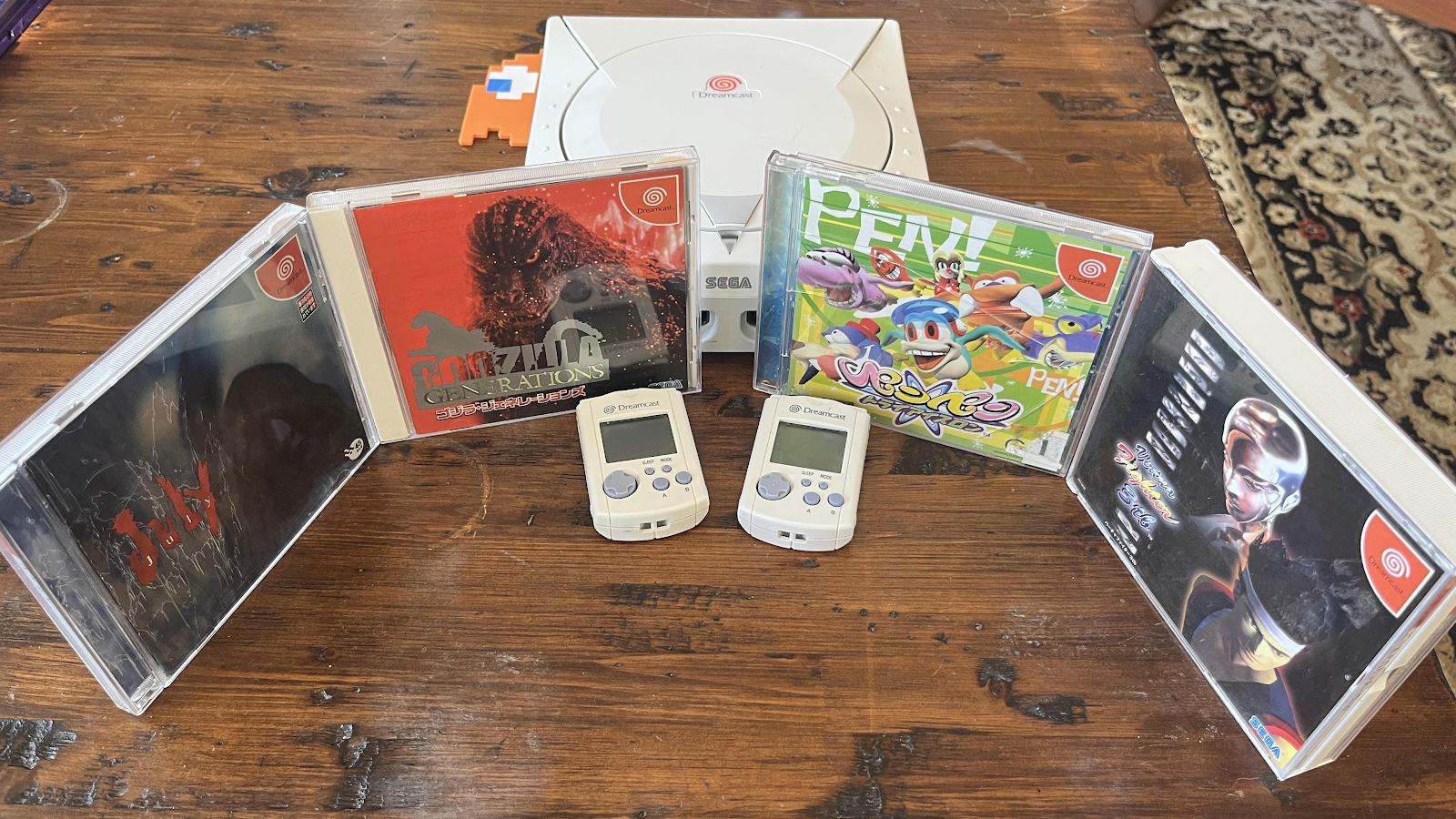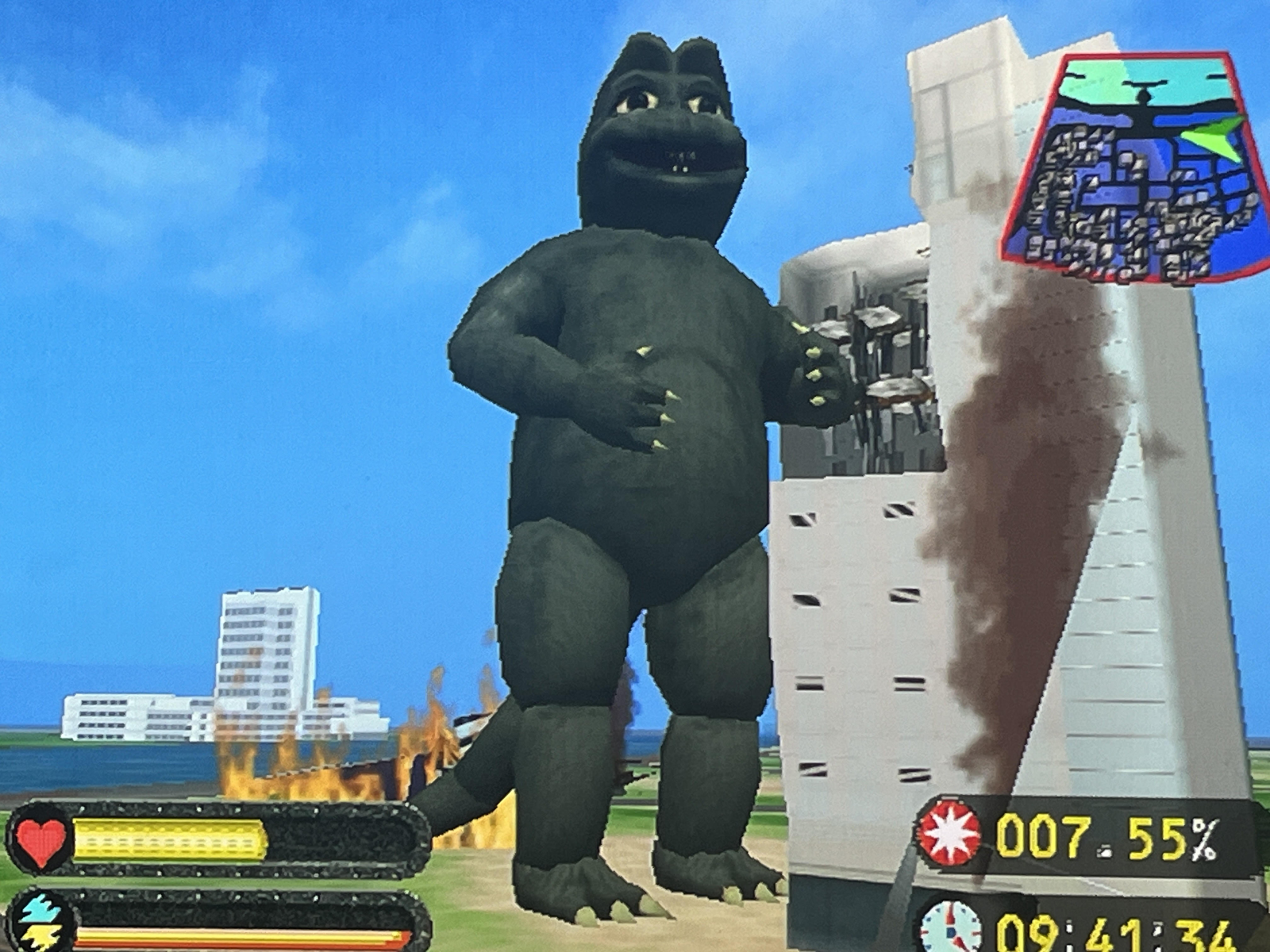Well, shit. It’s been 25 years…or 300 months…or over 13 million minutes. That’s how long it’s been since Godzilla Generations was unleashed in Japan.
And the Dreamcast, too, for that matter.
 |
| In our house, it's always November 27th, 1998. |
I was a tween when I first learned of Sega’s swansong console. Undeterred by President Shoichiro Irimajiri’s creepy disembodied head at the initial Dreamcast reveal, it was ultimately Sonic Adventure which ignited my hype for the platform and all the ambitious and imaginative experiences that would come to define it.
 |
| (From EGM #112 November 1998) Don’t tell tween me that middle-aged me kept this tattered mag. He’d think it was weird and sad and he’d probably be right. |
But the blue ‘hog was just the tip of the spear. With unprecedented visual and aural fidelity, groundbreaking online capabilities, intuitive hardware architecture, and a supplemental operating system, the Dreamcast fancied itself as both a developer-friendly haven and bleeding-edge forerunner of gaming’s future.
 |
| (Preserved by Unseen64.net) |
Elsewhere on the software front, Virtua Fighter 3tb, Get Bass/Sega Bass Fishing, and Sega Rally 2 signaled a renewed commitment to Sega’s iconic arcade experiences at home. Blue Stinger, Pen Pen TriIcelon, and Climax Landers (eventually released as Time Stalkers in the West) flaunted their vibrancy and helped crystallize the Dreamcast’s aesthetic. AM2’s Shenmue – known as 'Project Berkley' at the time – promised to help reimagine how players might inhabit dense and bustling virtual spaces. Meanwhile, the presence of Biohazard: Code Veronica and D2 hinted at resurgent third party support from large and small game makers alike. And Godzilla Generations…was also there.
Although most of Sega’s in-house projects had yet to be unveiled in depth, they’d go on to spark a creative and innovative renaissance that continues to endear the Dreamcast to us a full 2.5 percent of a millennium later.
 |
| (From EGM's 1999 Video Game Buyer's Guide) Some of the other games I was looking forward to. |
In the meantime, Sega faced hurricane-force headwinds as it prepared to get the thing off the ground. The community has expressed no shortage of anecdotes for all the challenges stacked against the company at the time. Among them, people often blame the following:
- Sega’s dwindling financial resources (i.e. capitalism*);
- A merciless competitive landscape amid Sega’s diminished command of industry trends (also capitalism*);
- The upcoming launch of the PlayStation 2 (capitalism strikes again!*);
- Intracompany divisions over the direction and priorities for the Dreamcast across regions;
- Sega's squandered goodwill with publishers, manufacturing partners, retailers, and consumers through several generations of missteps;
- Minimal time to prepare for the Japanese launch, yielding a meager day one lineup and delays for several would-be launch window titles;
- Shifting tides in consumer sentiment (sometimes people just like other things, you know?)
- Sega being Sega;
- Obama.
* I mean, maybe Sega just sucked at capitalism and that's totally OK. Would we really love the Dreamcast as much today if it had been managed by a more fiscally responsible and risk-averse company?
To me, Sega’s biggest challenges of the era were inseparable from its identity. The company’s deep-rooted stubbornness and rebelliousness – while enabling its uncompromising creativity and ambition – led it to hang its fortunes on innovations the public was not yet ready to embrace (e.g. online console gaming). At the same time, Sega continued to cling to established conventions which had fueled its past success and legacy but were falling swiftly out of vogue, globally (e.g. its arcade-centric ethos). In straddling the future and past, Sega found itself awkwardly out of step with gaming's present. Sega was a perpetual pioneer yet it struggled to meet people where they were, or adapt enough to counter its competitors’ most basic strategies to woo them. Sadly — insomuch as we can feel sad for a for-profit corporation — the world was growing ambivalent to Sega’s presence and there wasn’t much anyone could do about it.
 |
| (From the What's Shenmue? Dreamcast demo) |
In many ways, the Dreamcast’s Japanese launch reflected the history of this turmoil. And charmingly, Sega owned it. The company responded by promoting the platform in perhaps the most human way imaginable. Senior Managing Director Hidekazu Yukawa (R.I.P.) became the literal face of the Dreamcast to the point his image was emblazoned on a later edition of the console’s retail box. People knew him as Mr. Sega.
Sega’s Japanese Dreamcast advertising campaign was unconventionally humble and earnest, a likely reflection of Yukawa-san himself. Abandoning the brutish bluster of Segata Sanshiro’s salesmanship, Yukawa wore a friendlier face and carried a more genuine demeanor. Acknowledging the dire situation Sega found itself in, he made a gentler appeal to players. He was simply grateful for the chance they may invite the Dreamcast into their homes.
The Yukawa TV ads rolled with the punches with humility if not grace. In an early spot, demon children haunted Yukawa’s nightmares, exclaiming they didn’t need Sega just before a rift opened and swallowed him into an abyss. And when production challenges hobbled Sega’s ability to produce enough Dreamcasts to meet retail targets, Yukawa-san dedicated an ad to apologizing for the stock shortages while fans pelted him with trash (gamers, amirite?). Meanwhile, his wife wondered when he’d be done with making all these stupid commercials. It was a pitiful ad campaign in that Yukawa-san and Sega actively solicited our pity.
So yeah. Sega was having a rough time even without a new generation of competition looming in the next millennium. As such, the company aimed to seize as much of a head start as possible, hastening the Dreamcast to the Japanese market just to get it out into the world. No doubt Sega of Japan needed to start generating revenue and building a user base sooner rather than later. So as a byproduct of that, there was little time to develop games ahead of the Japanese launch. In fact, the Dreamcast rolled out with four whole titles on day one.
 |
| The Dreamcast lobster |
I recently revisited those Japanese launch games, so I'll ramble about them next...
Godzilla Generations
[An excerpt from a recent discussion I had with my fiancé...]
Me (starting my fourth playthrough of Godzilla Generations): “Why am I still playing this game?”
Fiancé: “I was wondering the same thing. I can only assume you’re getting some enjoyment out of it.”
Me: “Huh?"
Fiancé: ...
Me: "...Huh.”
Back in college, my roommate loved Godzilla. He even had every Godzilla DVD specially displayed in our living room. The only Godzilla thing I owned was Godzilla Generations and I loathed it, so I never had the heart to tell him about it.
Developed by General Entertainment, Godzilla Generations was a universally-derided, launch day punching bag. However, it technically made good on its core promise of being a big lizard and smashing stuff. And if that was your thing, you'd be especially disappointed. Moments into its lumbering and repetitive play — as the novelty of the elaborate destruction physics wore off — the design fell apart as readily as the combustible cityscapes Godzilla romps through. Generations’ cardinal sin? It was boring as hell.
But the thing is: I kind of like it now, actually?
Recently, I’ve come to recognize that Generations is the most faithful Godzilla simulator that could probably exist. It’s a slog, sure, but maybe that’s the point. Godzilla was slumbering peacefully in the ocean while we kept dumping nuclear shit on him. Do we think he was having fun with that? And when he awoke, do we think he had fun being greeted with artillery fire? He steps on buildings like they’re legos, but stepping on legos is certainly no fun. So when we see a pained and incensed Godzilla leveling cities, do we really think that looks neat? Oblivious to the allegory? Oblivious to the suffering of everyone involved?
And so it was for the Dreamcast owners of 11/27/98 as they powered up their new ¥29,800 toys, eager to indulge in playful kaiju hijinks. Little did they know their experience would align, not with the rampaging beast, but with the hapless people he crushed. Under the player’s control (more or less), Godzilla slowly decimated 99.24% of the city via gameplay that feels more like vacuuming than wanton mayhem. Then they likely spent several more minutes looking for the other 0.76% to no avail.
 |
| Godzilla would have destroyed 100% of Osaka but two trees survived simply by evading the view of his cinematographer. |
If nothing else, Godzilla Generations taught day one Dreamcast adopters a valuable lesson as it imparted to them the full scale of the monster’s suffering. Godzilla led a rote and excruciating existence and he didn’t want to be there any more than we do. If we thought his situation seemed fun, then misery is what we deserved.
As a work of interactive entertainment, Godzilla Generations is the worst. But as a sobering depiction of the mundanity and pointlessness of our insatiable carnage, it is a goddamn masterpiece.
Pro tip: Despite the intimidating destruction percentage and time limit counters on screen, you don’t actually need to do a lot to clear each stage. By taking out the enemy tanks and roughly a quarter of the structures, I was able to speedrun the game fairly easily. After a couple playthroughs, you unlock Hollywood Godzilla who moves quite fast and feels less cumbersome to play.
Virtua Fighter 3tb
For the centerpiece of the Dreamcast’s Japanese launch lineup, developer Genki adapted the third installment of AM2’s pioneering pugilist series. With only a few months to develop it, the studio was under pressure to expedite its conversion of the technically stunning Model 3 title. The port expectedly had its quirks but VF3tb held its own as the Dreamcast’s marquee showpiece at launch. Also, the “tb” stands for Team Battle, not Tuberculosis in case that clarification is needed.
For its part, Virtua Fighter 3tb certainly caught my attention. One of my local game shops was demoing the Japanese Dreamcast and VF3tb would be my first taste of the spiraled beast. I was quickly won over by the game’s deceptive simplicity and weighty feel. Blocking attacks left opponents stumbling awkwardly to recover and I was often distracted by the subtlety of their movements. I was also enamored by the varied stage layouts with their unique and uneven topography. The various slopes and stairs had me mind my positioning to avoid whiffing on high/low attacks and to do my damndest to knock opponents off of roofs and ledges. For me, VF3tb left a strong first impression and it’s only gotten better with time.
Ultimately, 3tb’s impact would be eclipsed by the show-stopping Soulcalibur and all the other heavyweight fighters the Dreamcast would later be known for. For what it's worth, I see this as a testament to the platform’s incredible fighting game library rather than an indictment of VF3tb. It was a golden age for the genre, and that's neither AM2 nor Genki's fault.
Distanced from the pressures of the Dreamcast’s launch and subsequent fighting game renaissance, 3tb stands strong on its own a quarter century later. Perhaps with 25 years of distance behind it, VF3tb’s reputation is due for reevaluation. And with its upcoming rereleases in Japanese arcades and as part of Like a Dragon: Infinite Wealth’s mini-game suite, it just might get it.
July
OK, so I actually couldn’t play FortyFive’s adventure game/visual novel given that it's super text and dialogue heavy and I don't speak Japanese. If anyone in the fan community plans to localize July any time soon — or is already working on it — that’d be rad as hell.
In the meantime, here's a playthrough (via SEGA-SKY on Youtube) if you’re curious about it.
Pen Pen TriIcelon
Developed by Land Ho! and General Entertainment, Pen Pen TriIcelon is a bizarre little game where you race hybrid penguin + [insert random animal] creatures through themed courses as they waddle, slide, and swim from segment to segment. Then it takes that premise and drowns it in a saccharine marinade of toy castles and jelly forests. As a teen, I half-dismissed the game as a curioddity: something I might rent just to check out its novel vibe but otherwise wouldn’t be caught dead having in my collection where my friends could see it.
Of course, that was precisely the wrong take. These days, I have the most fun with Pen Pen when I can share its absurdity with three friends gathered around my Dreamcast. Its multiplayer amplifies the zany chaos of a racer that was already unflinchingly weird and charming. Of the initial launch titles, Pen Pen is the one that best embodies the Dreamcast spirit as I would come to know and love it.
***
Looking back at the Japanese launch, it’s easy to discount it as a stumbling start for Sega’s swansong, but I see it as a series of necessary sacrifices for a company that was still reckoning with its fall from grace while embarking on an earnest path to atonement. Although I do believe the Dreamcast's fate was foregone long before November ‘98, I respect that period as the opening salvo for a console that would leave an indelible mark on everyone who kept the faith.
Sega would go on to parlay the lessons it learned in the lead up to the Japanese rollout to deliver two of the most memorable gaming launch spectacles in the medium’s history. If November 27th was the Dreamcast’s conception, then the following September 9th would be its birthday and October 14th its baptism. All of these occasions call for ample celebration and we are excited to keep the party going for years to come.
 |
| This party is just getting started... |
Cheers!
Brian (bsky: Jet Brian Radio / Twitter: @JetBrianRadio)















4 comments:
Love your writing style Brian. This piece has put a smile on my face, which is a tough ask on a Monday. I look forward to your forthcoming article in a top economics/business journal. title, abstract, and conclusion all one line "Why did the Dreamcast fail? Sega just sucked at capitalism" ;)
A thoughtful and hilarious piece, Brian!
Your bit on Godzilla Generations made me laugh out loud.
Woo! Dreamcast!
Excellent piece Brian!
Thanks all! Hope y’all had an awesome ‘Castiversary!
Lozz - Glad to have helped make Monday a little less shitty. You might be onto something with that. It often seems like there’s a cottage industry dedicated to relitigating Sega’s past and speculating all the coulda/woulda/shouldas to arrive at the definitive solution to its decline. But most of those theories all boil down to the same thing: If Sega were to find the level of success it deserved, it would’ve needed to not be Sega.
Post a Comment